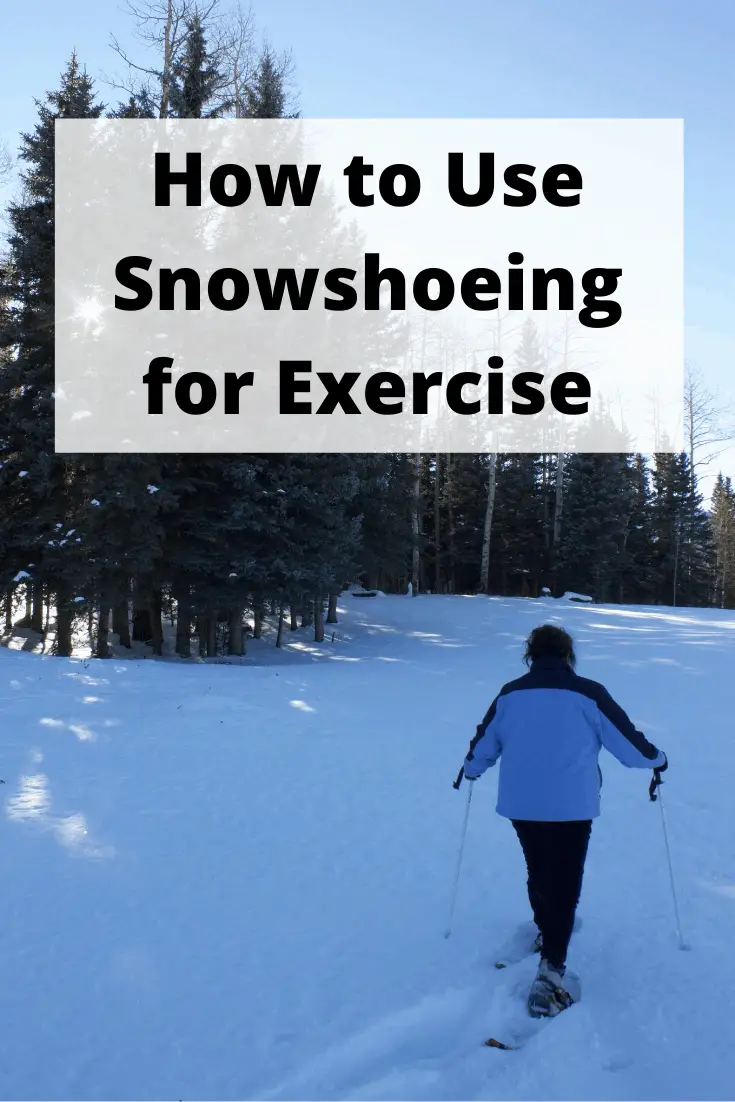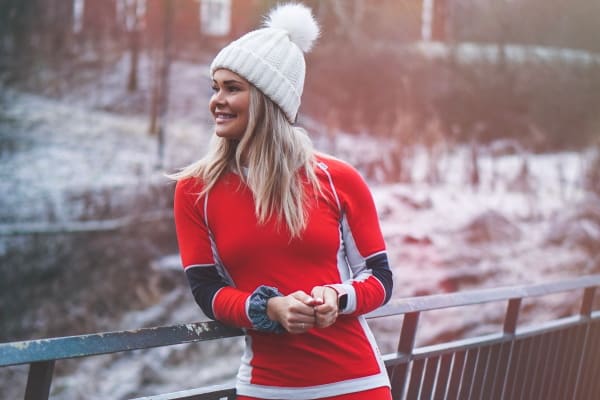
Snowshoeing is a great hobby that gets people outdoors even when it’s cold outside. I love it and try to do as much of it as I can each year. Not only does it get me out in nature but it also gives me another reason to exercise.
But how good is snowshoeing for exercise? Snowshoeing is a great alternative to traditional exercises. It offers a workout that could be considered cardio exercise as well as strength training.
On top of this, snowshoeing is said to burn a lot of calories. I’ve seen many snowshoeing websites like SnowShoeMag.com and snowshoe companies like Tubbs Snowshoes, cite that the University of Vermont and Ball State University have found that snowshoeing can burn between 500 and 1,000 calories per hour. Unfortunately, I’ve yet to find this information on either of these university websites.
This being said, I can attest first-hand that snowshoeing does seem to burn more calories than most other forms of exercise. Within an hour of snowshoeing, I’m always ravenous and I usually bring snacks along with me to eat as I go.
Here is a detailed look at the calories burned snowshoeing.
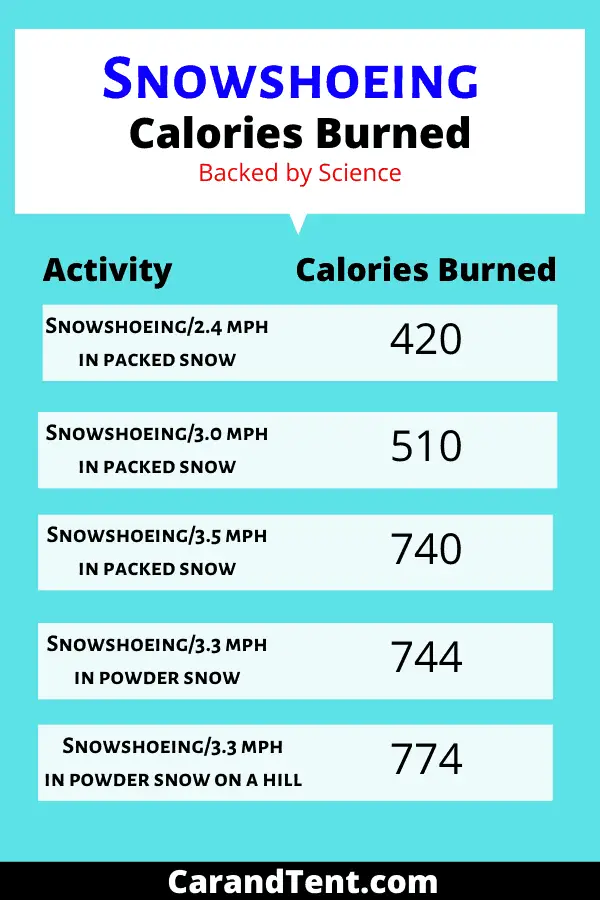
Let’s take a look at snowshoeing for exercise in even more detail below.
Table of Contents
Strength Benefits of Snowshoeing
Snowshoeing is a load-bearing exercise. This means that it stimulates the skeletal system and forces it to get stronger. The skeletal system includes all of your bones and joints.
On top of this, snowshoeing stimulates your muscular system as well. This includes your skeletal muscles, your smooth muscles, and even your cardiac muscles.
The reason for all of this comes down to the fact that you’re walking. However, snowshoeing is much more difficult than walking. When you’re snowshoeing, you have a few extra pounds strapped to each one of your feet. You also have a few extra pounds in each hand. I’m referring to your snowshoes and snow poles of course.
Additionally, you’ll probably have several extra pounds of winter clothing on as well as a backpack filled with additional gear. Even a snowshoeing daypack could add another 10 to 15 pounds of extra weight to your setup.
Considering all of this, you can expect strength gains in your legs, your hips, your core, your back, and your arms. You’ll be less likely to develop osteoporosis as you age and you’ll be much less vulnerable to injuries.
Cardio Benefits of Snowshoeing
The cardiovascular benefits of snowshoeing may be even more impressive than the strength benefits of snowshoeing. As we said earlier, snowshoeing gives your heart a fantastic workout. The reasons for this are two-fold.
For starters, you’re putting yourself through moderate to intense physical exercise which is known to force your heart and lungs to get stronger. On top of this, you’re out in cold temperatures. When you’re out in cold weather, your blood vessels must contract and your blood flow must speed up. It does this to help keep you warm and it’s perfectly natural.
However, this forces your heart to work even harder which is great for working out a healthy heart. One thing to note, however, is that this can put too much strain on an unhealthy heart. For this reason, it may be a good idea to get a physical checkup before you decide to do any cold weather exercises.
In the end, snowshoeing will increase your endurance, lower your chances of high blood pressure, heart disease, and diabetes. Of course, the benefits don’t end here.
Agility Benefits of Snowshoeing
Snowshoeing can also improve a person’s balance, coordination, and agility. The reason for this is that each step you take through the snow forces your body to adapt to the changing terrain. With snow, this can be true even on flat ground.
The continuous changes in terrain forces you to make continual shifts in your center of gravity and you have to work harder and harder to keep your balance. This can cause a dramatic increase in a person’s agility levels.
While we didn’t mention this in the strength section, it should also be noted that walking on uneven ground has been shown to work the hip flexors 65% to 85% more than walking on level ground. This means that your hip flexors will end up becoming much stronger through snowshoeing than they would through walking or running on a treadmill.
Mental and Emotional Health Benefits of Snowshoeing
While snowshoeing itself may not provide any direct emotional health benefits over other forms of exercise, being in nature will. The University of Minnesota states that being in nature has been shown to reduce feelings of stress, anger, and fear. It also reduces blood pressure and the production of stress hormones. So the next time, you begin to feel anxious, you may want to strap on a pair of snowshoes and hit the trails.
You won’t just get an emotional boost from snowshoeing either. Snowshoeing can also improve your mental health as well. Once again, the need to have to walk on uneven ground helps to provide you with health benefits. In fact, doing so can increase your short-term memory capabilities.
Do you forget people’s names as soon as they tell them to you? Do you need to make a list every time you go grocery shopping? Start snowshoeing and these problems may become a thing of the past.
Snowshoeing Vs Winter Hiking
Winter hiking is a lot of fun and I highly recommend it. If you’ve never done it before, I’d suggest you read my post titled, “How to Hike in the Snow – Tips for Staying Safe and Having Fun“. This being said, snowshoeing does have some advantages over winter hiking.
One of the obvious advantages is that you can snowshoe through much deeper snow than you can hike through. Snowshoes float over snow drifts so even if the snow is piled 6 feet high, you can move through it without having to worry about sinking 6 feet under.
Another advantage of snowshoeing versus winter hiking is that snowshoes offer much better traction than hiking shoes. This is true whether you wear stabilizers on your hiking shoes or not. The reason for this is that snowshoes are much wider than hiking shoes and they help to distribute your weight better while also providing a wider area of traction.
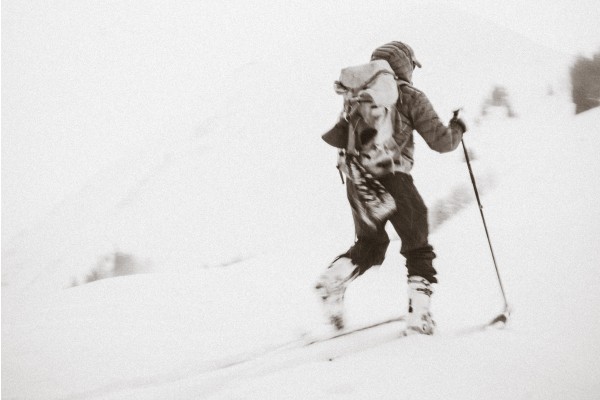
On the other hand, winter hiking does have some benefits over snowshoeing. The primary benefit is that you don’t have to buy as much gear. Even a beginner pair of snowshoes can cost over $100.00 and in areas where you don’t get a lot of snowfall, you may not even get to use your shoes each year.
The gear reduction can also increase the speed at which you can navigate some trails. This is especially true when the snow isn’t very high. A winter hiker might easily move at a speed of 3.5 mph while a snowshoer might be stuck at 2.5 mph.
Lastly, winter hikers don’t have to worry about getting a certain amount of snowfall to hit the trails. Snowshoers, on the other hand, need at least 6 inches of snow on the ground and preferably more to really take advantage of the snowshoes.
Snowshoeing Vs Trail Running
Trail running can be a lot of fun and it has a few advantages over snowshoeing. One of the main advantages is its ability to offer a superior cardiovascular workout. Trail runners can move at speeds much greater than snowshoers which puts more stress on the heart and lungs than snowshoeing. This leads to even greater improvements in heart rates versus snowshoeing.
Also, just like winter hikers, trail runners get to cover more ground with less equipment and at faster speeds than snowshoers. They also get to hit the trails whether there is snow or not.
Snowshoers, on the other hand, get to travel through areas with deep snow and they get to do it with much better balance. They also get additional strength gains that trail runners don’t get. This is partially due to the extra weight snowshoers carry and partially due to the change in the movement of walking versus running.
Snowshoeing also has fewer risks of injury than trail running. This is because snowshoeing is a low-impact exercise that puts less strain on a person’s joints. Trail runners are much more likely to develop injuries like shin splints, sprains, and other impact-related injuries that snowshoers are unlikely to develop.
Snowshoeing Vs Cross-country Skiing
Snowshoeing and cross-country skiing directly compete with each other each year. This is especially true for people that live in areas that don’t get a lot of snowfall. For this reason, people are constantly debating whether snowshoeing is better than cross-country skiing and vice versa.
Cross-country skiing has a big advantage when it comes to speed. A cross-country skier floats over the snow much easier than a snowshoer does and can essentially glide through x-country ski trails.
This sport also has even less of an impact on a person’s joints than snowshoeing does. Skiers don’t even have to lift their feet very often so they just aren’t in a position to fall victim to impact injuries.
For many people, x-country skiing is also a lot easier. The reason for this is that x-country skiing is less strenuous than snowshoeing. This has its plusses and minuses as you’ll get more health benefits from snowshoeing but at certain health and fitness levels, you may not actually be able to do it. Most people won’t have this problem with x-country skiing.
Snowshoeing does have an advantage when it comes to trail versatility. Snowshoers don’t need smooth or even trails and can essentially plow through most conditions. This makes snowshoeing perfect for backcountry adventures and hunting trips.
A snowshoer also doesn’t have to spend as much money on gear as a x-country skier. A cheap pair of xc skis are still going to cost about $150.00 and you can’t use them without poles. This puts the entry cost of x-country skiing higher than snowshoeing.
Snowshoe Calories Burned Vs Other Popular Outdoor Activities
Rather than compare the number of calories burned by each activity throughout the article, I figured I’d make things easy on you and create a chart for you. This data was collected from the University of Rochester’s calorie calculator. It assumes a weight of 150 pounds. If you weigh more, you’re likely to burn more calories, if you weigh less, you’re likely to burn fewer calories.
Feel free to Pin this chart to your Pinterest account, bookmark it, or link to it from your website.
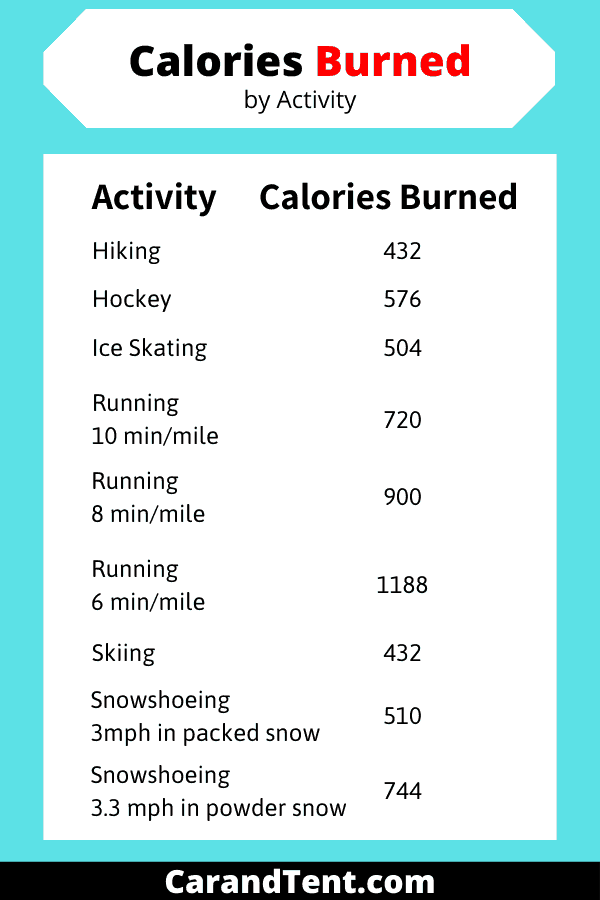
As you can see, the only activity that tops snowshoeing as far as calories burned is running. You may also want to take note that this is calories burned per hour and it’s generally easier for a person to snowshoe for an hour than it is to keep a 6 minute per mile pace up for an hour.
Additional Considerations Before Snowshoeing for Exercise
Snowshoeing might be a low-impact exercise with few chances of injury but it is a more advanced form of exercising. What I mean by this is that you really need to be in decent shape before you head out on any long-distance snowshoe excursions.
People who haven’t worked out in a while may want to do some hiking before they take on snowshoeing. This will get them used to walking on uneven ground and will build up their strength and stamina levels.
Folks who are at a moderate level of fitness may want to plan for shorter snowshoe trips on flat trails. Aim to do short loops of 1 or 2 miles and gradually increase your distances and speed as you become more comfortable with your snowshoes.

